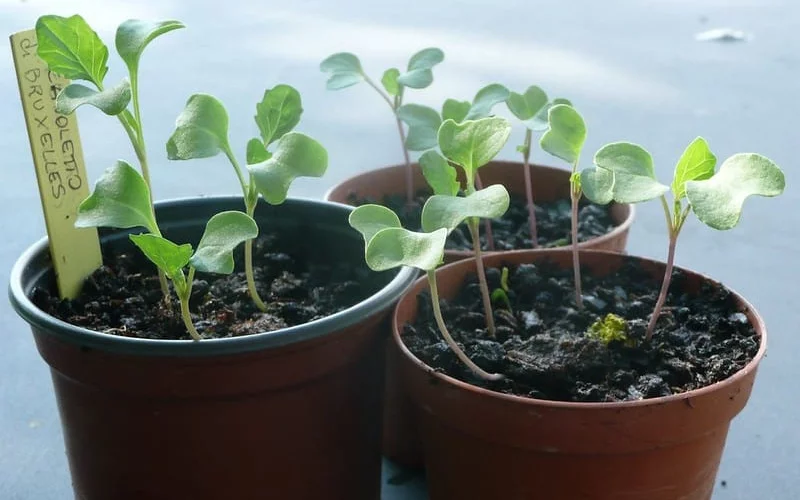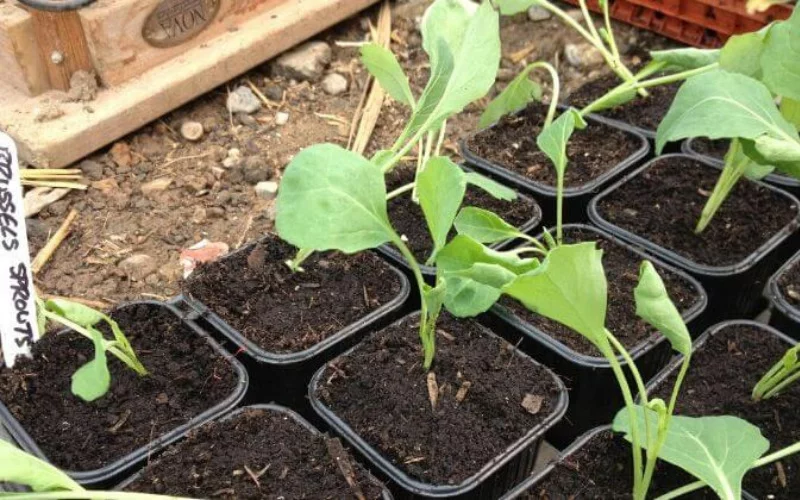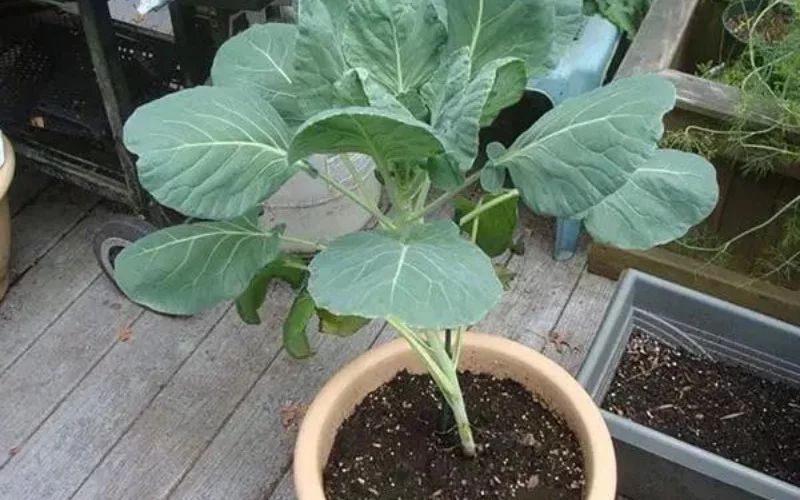Brussels sprouts are so delicious, so if you love this plant and want one, you don’t need to go all out and make a whole garden, especially if you have small yard space; all you need to do is plant them in containers.
You will want some important information on how to grow Brussel sprouts in containers at home, and frankly, it’s not a hard task to accomplish; all you have to do is follow directions properly.
Join us as we discuss the step-by-step procedure for planting Brussel sprouts in a container; we will also answer some of your frequently asked questions and how we’ll do these plants grow in containers.
Do Brussel Sprouts Grow Well in Containers?
Brussel sprouts grow and extend their stalks to a reasonable length, and to achieve this in a container, you need to choose the right one.
This plant grows well in containers, but its growth depends on the size of the container. You can use a clay pot that is 12 to 14binches deep and has a diameter of 12 to 15 inches.
If a clay pot is not available, you can use a 5-7 gallon container with a diameter of 18 inches. If these materials mentioned are not available, you can use another container of a similar size. A good example is a bucket.
How to Grow Brussel Sprouts in Your Garden

This section will give a detailed explanation of how to grow Brussel sprouts in your garden. The tools required are easily accessible, and the process doesn’t take a lot of time.
Materials Needed to Grow Brussel Sprouts
To successfully grow Brussel sprouts in your yard or garden, here’s what you’ll need.
- A container 12 to 14 inches deep and 18 inches in diameter (one foot deep and one-foot wide container)
- 1-gallon container
- Brussels seedlings
- Potting mix
- Pruning shears
- A transplanting tool, e.g., a hand shovel
- Controlled release fertilizer
- Soluble fertilizer
- An area with access to adequate sunlight
Comparing Potting Soil vs. Potting Mix
Potting soil is simply dirt or ordinary soil. It contains decaying organic matter that adds nutrients to the soil, suitable for indoor and container plants. One of the best things about potting soil is that it is very cheap and lasts longer than potting mix.
But then potting soil can be bad for your plants as they are heavy and compact when waterlogged. Another issue is that potting soil is tightly packed together and not fluffy. This leaves little room for your plant root to grow. This problem also makes the soil poorly aerated; in general, potting soil is not ideal for seedlings.
Potting mix is specially designed for container plants. It includes compostable organic matter, peat loss, perlite, and vermiculite. Potting mix can also be custom-made for specific plants; a good example is a cactus or orchid.
Potting mixes have a lightweight and fluffy texture that makes it easy for plant roots to pass through easily; they also have a good drainage system that makes soil aeration possible.
With all of the above added, your soil has the right nutrient mix, drainage, water retention, and soil aeration, which is very important for the plant.
Growing Brussel sprout in a container means you have to use loose soil that creates room for root growth and proper aeration; the potting mix is the ideal soil for growing Brussel seedlings.
Soil Requirements For Growing Brussel Sprouts
Your soil needs extra attention as it needs to meet the requirements for growing Brussel sprouts. The soil pH should be slightly acidic at 6.5 or completely neutral at 7.
Any other value above or below this is not suitable for Brussel sprouts to grow; your soil also needs a reasonable amount of organic matter to enrich the seedling and aid their growth.
Your soil needs to be moist at all times and not flooded with water.
Brussel sprouts do well in free and aerated soil that is not compacted. This plant grows well under a temperature between 45 degrees Fahrenheit to 75 degrees Fahrenheit; they prefer to grow under a cool temperature as it improves their flavor; a hot temperature only makes them bitter.
Fertilizer Needs
Brussel sprouts are significant feeders and will need many nutrients to grow. You can consider adding well rotten manure to the soil mix or good compost; another option will be to use fertilizers like 10-10-10, 5-10-5, 5-10-10, 14-14-14 controlled-release fertilizer, or 15-30-15 soluble fertilizer. These fertilizers provide a constant supply of nitrogen to your plant.
Grow Your Seedlings With Materials Needed
You may want to grow your Brussels sprout from scratch by using seeds, and that is fine; you can get these seeds from garden centers close to you, or you can purchase them online. To grow this plant using seeds, you will need the following materials.
- Seeds
- Potting mix
- Small plastic containers
- Scissors or a sharp knife.
- Spray bottle
Steps on How to Grow Your Own Brussel Sprout Seedling
After gathering all these materials, you can follow the steps below to plant Brussel seedlings.
Step 1:
Create drainage holes under the containers using scissors or a knife.
Step 2:
Fill each container with potting mix leaving one inch of space to prevent water from overflowing when watering.
Step 3:
Plant the seeds inside the potting mix. They should be about ½ inch deep.
Step 4:
Place your containers in an area with adequate sunlight; they need at least six hours of sunlight.
Step 5:
Always keep your Brussel seedlings moist. This can be achieved by using a spray bottle not to flood the soil.
Step 6:
Transplant when your Brussel sprout has grown up to 5 to 7 inches.
Start Brussel Sprouts in Containers at Home

This section includes a detailed guide on growing and caring for Brussel sprouts. We have already listed the materials needed earlier to jump into the steps.
Step One:
Get a decent container. Your container should have a diameter of 18 inches and a depth of 12 to 14 inches. A more accurate measurement is one foot wide and one foot deep.
Make holes underneath your container for proper drainage; if you grow Brussel sprouts inside your home, you will need a tray to collect the drained water.
Step Two:
Buy some potting mix as it is great for soil drainage and aeration. It also contains organic matter that supplies your plant with adequate nutrients.
Step Three:
After filling your container with ng mix, add 1½ tablespoon of 14-14-14 control release fertilizer to the mix. You can also choose to use organic fertilizers like manure and compost.
Step Four:
This is a step that some people skip during planting, but it is very important. Water your potting mix before planting the seeds. Knowing that your mix has received enough water will see water seeping out of the drainage holes.
Step Five:
Transplant your brussel sprout when it is about 5 to 7 inches tall. You can do this by using a hand shovel. And if your container is big enough, you can grow more than one seedling.
Step Six:
Keep your brussel sprout in an area with just enough sunlight; your plant should receive at least six hours of sunlight a day.
Step Seven:
Water your plant regularly; outdoor Brussel sprouts will need more water than those grown indoors. Your soil should be kept moist at all times; this does not necessarily mean watering it; you can keep it moist by misting it using a spray bottle.
You may have a problem telling if your soil needs moisture, so here is a simple guide on how to determine if your potting mix needs moisture.
Pick up a wooden stick and insert it into the potting mix. If damp soil particles stick to the wood, it is moist, but if dry soil crumbles off the wood easily, it needs moisture.
Step Eight:
After your initial fertilizer application, you should feed your soil some more nutrients six weeks after growing your Brussel sprout.
Mix 1tbsp of 15-30-15 Soluble fertilizer with 1 gallon of water; you can use this water to moisten your soil once every two weeks.
Step Nine:
When your plant begins sprouting, pluck off some of the lower leaves to focus the plant’s energy on sprouting. Using pruning shears, cut off the stalk just at the top of the plant. This should be done when your sprouts are about 0.5 to 1 inches in diameter.
Step Ten:
When your sprouts have finally grown to a point where It is 1 to 2 in diameter, you can now harvest them.
FAQs About Growing Brussel Sprouts
After reading all of this, you probably have some questions. Fortunately, we have created this section to answer all of your frequently asked questions.
Q1: Can Brussel Sprouts be Grown in a Bucket?
Buckets are also considered containers, and you can grow Brussel sprouts in them as long as they meet the requirements.
Your bucket should be 12 inches deep, and it should have a diameter of 18 inches. You should also make holes underneath the bucket to serve as a drainage system.
Q2: What Month Do You Plant Brussel Sprouts?
We discussed earlier that Brussels sprouts grow well in low temperatures. You should plant your Brussel seedlings 6 to 10 weeks before the anticipated frost.
For a region that experiences winter below a freezing point, you can plant Brussel sprouts in early fall, which is September. Still, in regions where winter occurs below freezing point, you should plant your seedlings during mid-summer June.
Since it takes 85 to 120 days for many Brussel sprouts to mature, you should harvest a delicious sprout by late fall or early winter.
Q3: How Many Brussel Sprouts Do You Get From One Plant?
While there is no set number as to how many sprouts can be produced, a single Brussel plant can produce between 2 to 50 sprouts, depending on when the seedlings were planted.
When harvesting during summer, you get fewer sprouts than when you harvest during fall or winter. A more accurate answer is that one bag can produce 3lbs worth of sprouts.
Q4: How Many Brussels Sprouts are in a Container?
You can give only one Brussels plant with a standard-sized container (12 inches deep, 18 inches wide). But if you have a larger container, you can grow between 2 to 3 Brussel plants or more depending on how big the container is.
Q5: How Long Does it Take Brussel Sprouts to Grow?
There are different varieties of Brussel sprouts, and they each have different maturity periods, but you should expect your Brussel sprouts to grow within 85 to 120 days fully.
Q6: What Can You Plant Next to Brussel Sprouts?
Maybe you want to explore more plants, well you should know that Brussels sprouts have good companions. It is best to plant aromatic herbs like cinnamon, rosemary, and parsley next to Brussel sprouts. But you have to keep these plants at a considerable distance away from Brussel sprouts as it attracts pests.
Q7: Do Brussel Sprouts Need Deep Soil?
Brussels needs deep soil to accommodate its root extension freely. The soil should be well aerated and lightweight to avoid compaction.
Conclusion
We have given a detailed guide on how to grow Brussel sprouts in containers at home. The basic rules for this to happen are to get the right container, have the right soil mix, treat your plant to enough sunlight, and give it enough moisture.
Other maintenance can be carried out by pruning and the addition of fertilizer. Plant your Brussel sprouts close to fall or winter; this is important because sprouts harvested within this period taste better, and they have more yield.
Helpful Links:
- Tips for Growing Lavender in Florida
- Can You Dethatch St. Augustine Grass?
- How to Care For A Monstera Adansonii Plant?
- What Is The Best Time To Plant Bermuda Grass Seeds?
We trust this article helped you learn how to grow Brussel sprouts in containers at home. You may also want to check out How to Grow Yellow Daisies in Your Garden.
Thanks for taking the time to read our article, and we hope you find it helpful. Would you mind leaving a comment below if you have any suggestions?
Kindly reach out to people by sharing this post on social media.
If you liked this article, then please follow us on Facebook, Instagram, Twitter, and Pinterest.

